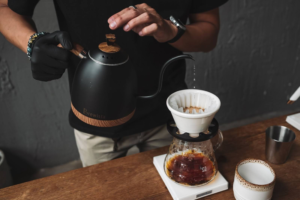
Last-Minute Rakhi Gift Ideas That Aren’t Boring: Surprise Your Sister with Specialty Coffee!
Rakhi isn’t just about the thread, it’s about the bond, the banter, and the thoughtful gifts that say “I care.” As siblings scramble to find
Indian coffee drinkers are now evolving from instant mixes to rich, aromatic specialty brews with complex flavors and sustainable origins behind them. This exciting shift has encouraged many to seek a proper coffee guide for beginners who want more than just their daily cup. Specialty coffee refers to beans graded highly for quality, grown under ideal conditions and processed with great care and transparency. This means every cup reflects hard work, attention to detail, and a unique story from the plantation all the way to your mug.
For Indian beginners, this presents a wonderful opportunity to experience coffee like wine—full of tasting notes, regions, and character. Paul John Caffeine has designed a coffee guide to simplify your entry into the vast and rewarding world of specialty Indian coffee. As awareness grows, Indian cafes and roasters are proudly showcasing beans from Karnataka, Tamil Nadu, and even emerging estates in Kerala. Let’s break down what makes specialty coffee special, how to brew it, and why it’s worth every thoughtful sip you take.
Specialty coffee begins with high-quality Arabica beans that score over 80 points on a scale by trained coffee graders. These beans are grown in optimal altitudes, climates, and soil conditions—often under shade, in biodiversity-rich South Indian plantations.
Farmers hand-pick only ripe cherries, and processing is done carefully to preserve flavor, avoid defects, and maintain traceability. Unlike mass-market beans, these are roasted in small batches to highlight natural tasting notes like chocolate, berries, or floral hints.
Your typical coffee guide for beginners must include this difference—it’s the key to unlocking better flavor and ethical sourcing practices. Specialty coffee is never pre-ground and stale; it’s often freshly roasted and sold whole beans for ultimate brewing freshness and control. The goal is to help consumers appreciate origin, variety, processing style, and roast profile—just like you would with single malt whisky. These factors combine to create a more authentic, artisanal experience than pre-blended instant or vending machine coffees ever could.
Before diving in, the most important tool in a coffee guide is understanding freshness, grind size, and water temperature. Always buy freshly roasted beans with a roast date, and store them in airtight containers away from light and moisture. Grind your beans just before brewing; the size should match your method—coarse for French press, fine for espresso, medium for pour-over. Use filtered water at around 92–96°C, never boiling hot, to extract flavor without burning the coffee and creating bitterness.
Follow a coffee-to-water ratio, such as 1:15 or 1:16, for balance—15 grams of coffee for 225ml water works very well. Start with simple brewing gear like a French press, moka pot, or South Indian filter before experimenting with complex pour-over setups. Keep tasting notes during each brew; observe acidity, sweetness, mouthfeel, and aftertaste—this practice helps refine your coffee palette faster. It’s completely fine to experiment with milk, but first try a few black cups to discover the bean’s true profile and flavor.
India produces incredible Arabica beans with notes of spice, cocoa, nuts, and fruit grown in shade and eco-friendly conditions. Coorg, Chikmagalur, Baba Budangiri, and Nilgiris are famous not just for volume but also quality and history in coffee production in India. Local roasters now work directly with farmers, creating ethical supply chains that pay growers fairly and promote sustainable agricultural practices. By supporting Indian special coffee, beginners contribute to an ecosystem of responsible farming, biodiversity, and community development in rural areas.
A complete coffee guide should celebrate these values—drinking great coffee and making a positive impact go hand-in-hand.
Many Indian cafés now offer cupping sessions, roastery tours, and brewing workshops to deepen public understanding of the coffee journey. As global demand for traceable and ethical beans grows, India’s role as a specialty producer is finally receiving well-deserved recognition worldwide. It’s an exciting time to be a coffee drinker—never has the opportunity to explore locally grown excellence been more accessible.
A good coffee routine starts not just with beans but with setting an intention to enjoy and understand what’s in your cup. Create a small coffee nook at home with your brewing tools, grinder, filters, and perhaps a logbook to track experiments. Make mornings peaceful by mindfully preparing your coffee, using the aroma and process as part of your daily grounding ritual. This is where Paul John caffeines coffee guide helps—teaching you to create not just a drink, but a meaningful experience.
Once you find your favorite bean, explore others: natural vs washed processing, light vs medium roast, or single origin vs blend. Engage with your local roaster, try limited harvests, and ask questions—each bag is an education, not just a purchase. Finally, share your love of coffee with friends and family—great brews spark conversations, connections, and shared moments worth remembering. You’re not just learning how to make coffee; you’re learning to appreciate craftsmanship, culture, and the journey in every single sip.
Start your special coffee adventure with our beginner-friendly brews—crafted from premium beans and roasted to perfection just for you. Call us now to grab your coffee beans.

Rakhi isn’t just about the thread, it’s about the bond, the banter, and the thoughtful gifts that say “I care.” As siblings scramble to find

Storing coffee beans the right way can dramatically improve the quality of your daily brew. Oxygen, light, heat, and moisture are the main enemies of

Coffee isn’t just a morning beverage, it’s a craft, culture, and sensory experience. Whether you enjoy a cappuccino or cold brew, the journey from casual
Powered by Kilowott